Module 1 Unit 2 Watch it grow 单元整体规划+表格式教案(4个课时)
文档属性
| 名称 | Module 1 Unit 2 Watch it grow 单元整体规划+表格式教案(4个课时) |
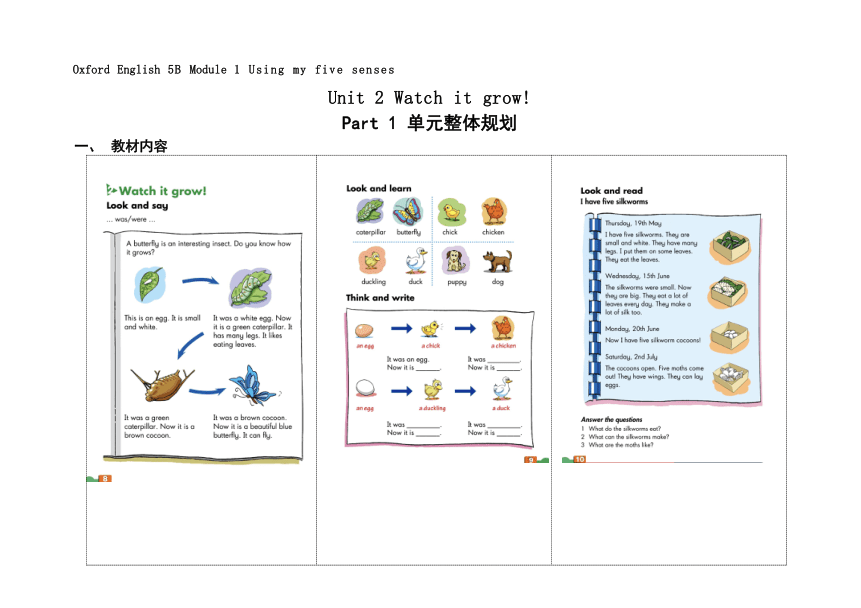
|
|
| 格式 | docx | ||
| 文件大小 | 5.7MB | ||
| 资源类型 | 教案 | ||
| 版本资源 | 牛津上海版(试用本) | ||
| 科目 | 英语 | ||
| 更新时间 | 2024-02-21 09:38:13 | ||
图片预览

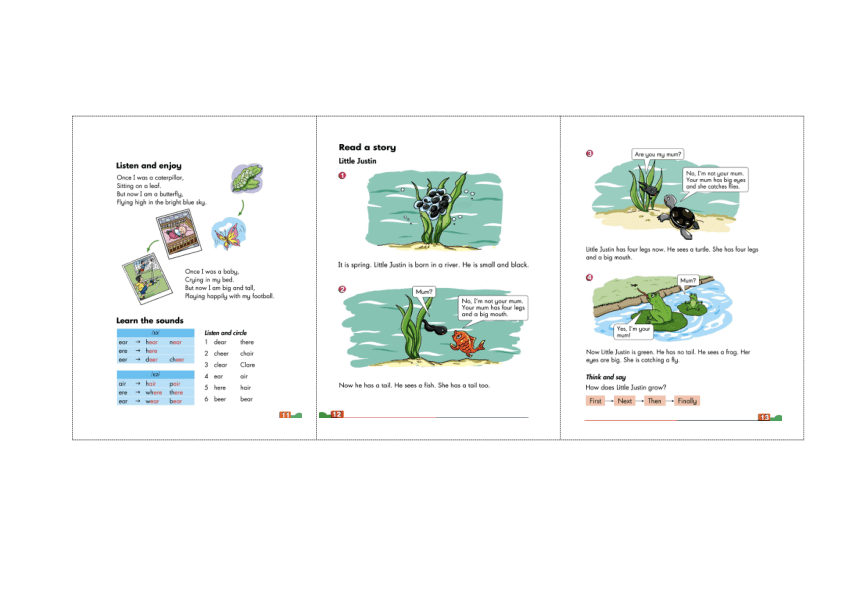
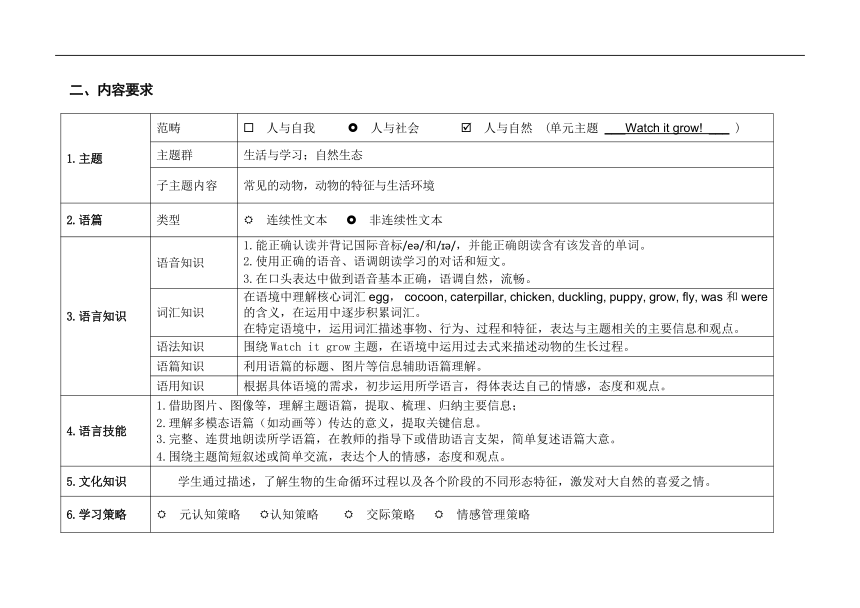
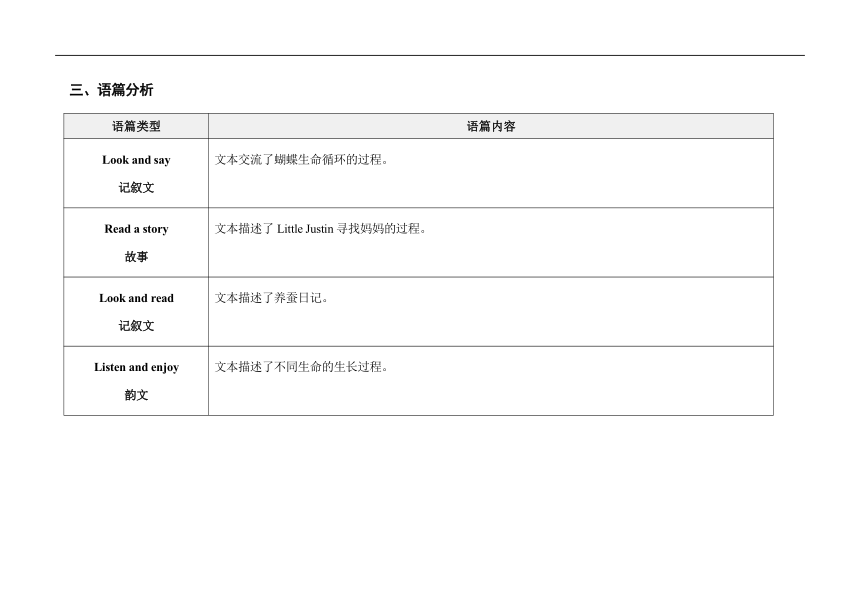
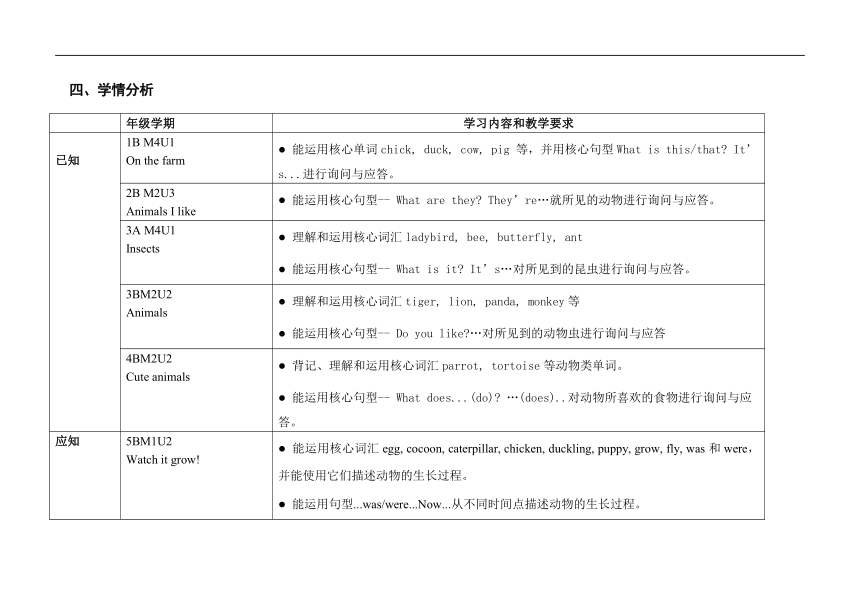
文档简介
Oxford English 5B Module 1 Using my five senses
Unit 2 Watch it grow!
Part 1 单元整体规划
教材内容
二、内容要求
1.主题 范畴 人与自我 人与社会 人与自然 (单元主题 ___Watch it grow! ___ )
主题群 生活与学习;自然生态
子主题内容 常见的动物,动物的特征与生活环境
2.语篇 类型 R 连续性文本 非连续性文本
3.语言知识 语音知识 1.能正确认读并背记国际音标/e /和/ /,并能正确朗读含有该发音的单词。 2.使用正确的语音、语调朗读学习的对话和短文。 3.在口头表达中做到语音基本正确,语调自然,流畅。
词汇知识 在语境中理解核心词汇egg, cocoon, caterpillar, chicken, duckling, puppy, grow, fly, was和were的含义,在运用中逐步积累词汇。 在特定语境中,运用词汇描述事物、行为、过程和特征,表达与主题相关的主要信息和观点。
语法知识 围绕Watch it grow主题,在语境中运用过去式来描述动物的生长过程。
语篇知识 利用语篇的标题、图片等信息辅助语篇理解。
语用知识 根据具体语境的需求,初步运用所学语言,得体表达自己的情感,态度和观点。
4.语言技能 1.借助图片、图像等,理解主题语篇,提取、梳理、归纳主要信息; 2.理解多模态语篇(如动画等)传达的意义,提取关键信息。 3.完整、连贯地朗读所学语篇,在教师的指导下或借助语言支架,简单复述语篇大意。 4.围绕主题简短叙述或简单交流,表达个人的情感,态度和观点。
5.文化知识 学生通过描述,了解生物的生命循环过程以及各个阶段的不同形态特征,激发对大自然的喜爱之情。
6.学习策略 R 元认知策略 R认知策略 R 交际策略 R 情感管理策略
三、语篇分析
语篇类型 语篇内容
Look and say 记叙文 文本交流了蝴蝶生命循环的过程。
Read a story 故事 文本描述了Little Justin寻找妈妈的过程。
Look and read 记叙文 文本描述了养蚕日记。
Listen and enjoy 韵文 文本描述了不同生命的生长过程。
学情分析
年级学期 学习内容和教学要求
已知 1B M4U1 On the farm ● 能运用核心单词chick, duck, cow, pig 等,并用核心句型What is this/that It’s...进行询问与应答。
2B M2U3 Animals I like ● 能运用核心句型-- What are they They’re…就所见的动物进行询问与应答。
3A M4U1 Insects ● 理解和运用核心词汇ladybird, bee, butterfly, ant ● 能运用核心句型-- What is it It’s…对所见到的昆虫进行询问与应答。
3BM2U2 Animals ● 理解和运用核心词汇tiger, lion, panda, monkey等 ● 能运用核心句型-- Do you like …对所见到的动物虫进行询问与应答
4BM2U2 Cute animals ● 背记、理解和运用核心词汇parrot, tortoise等动物类单词。 ● 能运用核心句型-- What does...(do) …(does)..对动物所喜欢的食物进行询问与应答。
应知 5BM1U2 Watch it grow! ● 能运用核心词汇egg, cocoon, caterpillar, chicken, duckling, puppy, grow, fly, was和were,并能使用它们描述动物的生长过程。 ● 能运用句型...was/were...Now...从不同时间点描述动物的生长过程。
Part 2 单元整体设计
一、单元主题内容框架图
单元主题: Watch it grow!
二、单元学习目标
知识与技能
能正确认读并背记国际音标/e /和/ /,并能正确朗读含有该发音的单词。
2. 能运用核心词汇egg, cocoon, caterpillar, chicken, duckling, puppy, grow, fly, was和were,并能使用它们描述动物的生长过程。
3. 能运用句型...was/were...Now...从不同时间点描述动物的生长过程。
4. 能理解和朗读相关语篇,梳理相关信息,借助语篇结构,尝试模仿介绍其他动物的生命循环过程。
主题与文化
了解生物的生命循环过程以及各个阶段的不同形态特征,激发对大自然的喜爱之情。
思维与策略
能积极参与课堂学习活动,认真思考,注意倾听,主动探究。
2. 能通过文本视听、阅读思考、信息判断、看图说话、问答交流、小组合作等形式完成学习任务,形成理解力、分析力、判断力、推断力、评价力、综合力。
【单元学习任务】
学生能对动物生命循环中各个阶段的形态特点进行简单描述,理解动物的生长过程。要求语音语调正确,内容完整达意,表达流利,拼写和语法基本正确。
三、分课时学习目标
知识与技能 主题与文化 思维与策略 学习任务
第一课时 1. 初步学习国际音标/e /和/ /,了解其读音规则,尝试朗读含有这个音素的单词。 2. 知晓egg, cocoon, caterpillar, chicken, duckling, puppy, grow, fly, was和were等单词的发音和含义,能听懂、读懂和正确书写,并在语境中尝试表达。 3. 在语境中知晓、理解句型...was/were... Now...并对蝴蝶的生长过程进行介绍。 4. 能理解并朗读语篇,梳理结构,获取信息,进行简单询问和应答。 介绍蝴蝶的生长过程,感受生命循环的过程。 通过视听感知、文本朗读,观察倾听等方式学习语言知识,形成观察力、理解力。 学生能扮演文中人物,初步了解毛虫破茧成蝶的过程,并根据图片说出其生长阶段的名称与特征。
第二课时 1. 正确认读国际音标/e /和/ /,正确朗读含有/e /和/ /的单词,并能根据发音规律进行辨析。 2. 在语境中理解并运用egg, cocoon, caterpillar, chicken, duckling, puppy, grow, fly, was和were等核心单词。 3. 在语境中运用核心句型...was/were... Now...描述农场上动物的生长过程。 4.能理解并朗读语篇,梳理结构,获取信息,简单介绍上动物的生长过程。 参观农场动物,了解动物的生命循环,感受大自然 通过视听感知、观察倾听等方式获取信息,形成观察力、理解力。 学生能扮演文中人物,从名称、形态、能力来描述所见的农场动物。
第三课时 1. 正确认读国际音标/e /和/ /,正确朗读含有音素/e /和/ /的单词,并能根据发音规律进行归类。 2. 在语境中正确拼读核心词汇egg, cocoon, caterpillar, chicken, duckling, puppy, grow, fly, was和were,感知silkworm,moths,wings和lay eggs,并了解其含义。 3.正确运用核心句型...was/were... Now...描述蚕的生长过程。 4. 在语境中理解语篇内容,获取相关信息,能结合关键词进行简单复述。 记录蚕的生长过程,感受生命的奇妙。 通过文本阅读、问答交流、信息判断等形式形成理解力、判断力、分析力和综合力。 学生能扮演文中人物,从飞蛾生长的阶段名称、形态、能力等进行简单描述。 。
第四课时 1. 正确认读国际音标/e /和/ /,尝试根据发音规则正确朗读含有音素/e /和/ /的单词。 2. 在语境中正确运用核心词汇egg, cocoon, caterpillar, chicken, duckling, puppy, grow, fly, was和were,能听懂、读懂be born,catch flies。 3.能灵活运用核心句型...was/were... Now...对青蛙的生长过程进行交流和表达。 4. 在语境中理解语篇并获取相关信息,提炼信息,以口头和书面的方式完成青蛙的生命循环。 交流青蛙的生命循环,感受生命的美好。 通过文本视听、信息判断、问答交流、角色扮演等方式形成观察力、理解力和判断力。 学生能扮演故事人物,理解故事内容并能简单复述Little Justin在找妈妈的过程中从小蝌蚪长成青蛙的过程。
Part 3 单课教学设计
一、第一课时教学设计
(一)第一课时学习语篇
Miss Fang: A butterfly is an interesting insect. Do you know how it grows Danny: Please tell us about it, Miss Fang!
Miss Fang: This is the life cycle of a butterfly.
Danny: What is this, Miss Fang
Miss Fang: It's an egg.
Danny: This is an egg. It's small and white. It stays on the leaf.
Miss Fang: That's right.
Miss Fang: It was a white egg. Now it is a green caterpillar. It has many legs. It likes eating leaves.
Alice: Oh! It grows quickly, Miss Fang.
Miss Fang: Yes. It was a big green caterpillar. Now it is a brown cocoon.
Miss Fang: Finally, what comes out of the cocoon, children
Danny: It was a brown cocoon. Now it is a beautiful butterfly. It can fly.
第一课时学习过程
学习活动 活动目标 学习内容 学习方式 活动资源
学习理解 借助图片、音频,学习国际音标/e /和/ /,并跟读含有该音标的单词。 Sounds learning Look and learn 1-2 Look and read 视频
通过儿歌,学习本单元核心词汇与句型。 Know about the butterfly. 2-1 Look and learn 2-2 Look and read 视频 图片 文本 音频 板书
通过问答交流、看图说话等形式学习本单元核心词汇与句型,表达看到的动物和昆虫。 Talk about the butterfly. 3-1 Let’s learn 3-2 Try to say 3-3 Try to read 视频 板书
实践体验 结合生活经验,尝试表达所见所闻。 Know how the butterfly grows. It is an egg. It is a caterpillar. It is a cocoon. It is a butterfly. 4-1 Think and say 4-2 Watch and say 5-1 Ask and answer How is the egg It's small and white. Where does it stay It stays on the leaf. 6-1 Look and say It is green. It is small. It eats leaves. 7-1 Look and learn 7-2 Look and say 8-1 Read and write 8-2 Look and read 8-3 Look and say 板书 文本 图片 音频
构建运用 运用所学,尝试表达蝴蝶的变化过程。 9.The life cycle of a butterfly 9-1 Listen and enjoy 9-2 Look and read 图片 文本
Assignment 1.Look and read (Textbook P8, P11) 2.Read and write(Work book P11H) 3.Draw a life cycle of a butterfly and talk about it.
Board design
二、第二课时教学设计
(一) 第二课时学习语篇
It's a nice and warm day. Miss Fang and the children go to the fa rm. They want to know how animals grow.
Danny: What a lovely farm! We can see animals here and there.
Danny: The dogs run happily. But look at that one, it always sleeps.
Miss Fang: Because it's old. It was a cute puppy. But now it is an old dog.
Jill: Oh, ducklings! I like the story ‘The Ugly Duckling'.
Miss Fang: Look at the yellow ducklings. They were white eggs.
Miss Fang: Shh ... Be quiet. The hen is laying eggs.
Alice: They were eggs first. Then they became chicks. Now they are chickens. That's interesting.
Danny: I was a little baby. Now I am a big and tall boy!
Miss Fang: Yes, you're right.
第二课时学习过程
学习活动 活动目标 学习内容 学习方式 活动资源
学习理解 检测作业 1.Homework checking 1-1 Listen and enjoy 1-2 Read and match. 1-3 Talk about the life cycle of a butterfly 视频 文本 图片
复习字母组合的发音 2.Sounds learning 2-1 Look and read 2-2 Look and classify 视频
通过问答交流、看图说话等形式学习本单元核心词汇与句型,表达在农场上看到的动物和昆虫。 3.Talk about the farm 3-1 Read and guess What place is this rhyme about 3-2 Listen and think 图片 文本 音频 视频
实践体验 通过大问题Why梳理脉络。 通过观察puppy,ducklings,chicks的生长过程理解生命周期的意义。 4.A visit to a farm 5.Puppy ―> dog 6.Ducklings ―> ducks 7. Chicks ―> chickens 4-1 Ask and answer 4-2 Look and say 5-1 Look and learn: dog, puppy 5-2 Watch a video and write the different stages of the dog 5-3 Look and say 6-1 Ask and answer 6-2 Look and learn 6-3 Listen and read. 6-4 Listen and answer 7-1 Listen and answer:What is laying eggs 7-2 Listen and read 7-3 Look and say 7-4 Look and read 板书 图片 文本 音频 图片 音频 视频 板书
构建运用 整体感知,结合所学,整体输出 Story reviewing 8-1 Listen and enjoy 8-2 Try to say 图片 文本
Assignment Listen and read (Textbook P8, P9) Think and write (Textbook P9) Read, choose and complete(Work sheet)
Board design 5BM1U2 Watch it grow! Period 2 A visit to the farm
三、第三课时教学设计
(一) 第三课时学习语篇
Peter: I have some eggs today. Whose eggs are they Let's wait and see.
(Peter's diary )
Thursday, 19th May
I have five silkworms. They are small and white. They have many legs. I put them on some leaves.
Wednesday, 15th June
The silkworms were small. Now they are big. They eat a lot of leaves every day. They make a lot of silk too.
Monday, 20th June
Now I have five silkworm cocoons! They are soft and white.
Saturday,2nd July
The cocoons open. Five moths come out! They look like butterflies. But they are brown. They have wings. They can lay eggs.
第三课时学习过程
学习活动 活动目标 学习内容 学习方式 活动资源
学习理解 复习字母组合的发音 检测作业,复习巩固上一课时内容 Sounds learning 2. Homework checking 1-1 Listen and enjoy 1-2 Look and read 2-1 Talk about the life cycle of a butterfly 2-2 Check the workbook 2-3 Read the sounds and words 2-4 Talk about the life cycle of the animals 视频 文本 图片 文本 任务单
实践体验 观察图片,了解本课主题 感知日记格式,累积生活经验 通过问题引领,结合生活经历,引导学生用核心句型描述silkworm不同阶段的变化, 通过不同问题设置,找寻信息,理解语篇,并尝试描述图片信息。 3.Eggs 4.The dairy on: 19th May (small silkworms) 5. The dairy on: Wednesday, 15th June (big silkworms) 6. The dairy on: Monday,20th June 7. The dairy on: Saturday,2nd July 3-1 Look and say 3-2 Watch and think 3-3 Look and learn: diary 4-1 Look and listen 4-2 Ask and answer 4-3 Look and learn: were 4-4 Look and say They were . Now they are . 4-5 Try to say 5-1 Watch and think 5-2 Read and fill 5-3 Listen and read 5-4 Look and say They were . Now they are . 6-1 Read and choose: What does Peter have now 6-2 Look and learn: cocoon 6-3 Talk about the life cycle of silkworms 6-4 Look and read 7-1 Watch a video 7-2 Look and learn: moth 7-3 Look and answer 7-4 Talk about the life cycle of moths 图片 音频 视频 图片 音频 文本 图片 音频 文本 板书 视频 音频 文本 图片 图片 视频 音频 文本
构建运用 整体感知,结合所学,整体输出 8.Diary reviewing 8-1 Look and listen 8-2 Look and order 8-3 Try to be Peter and introduce the life cycle of moths 8-4 Read Peter's Diary 8-5 Enjoy the video about the moths' life 图片 文本 音频
Assignment Think and write(Peter's diary on 3rd July) Listen and read (Textbook P10) and answer the questions. Read and write(Work book P10 (E) ,P11 (G)) Listen(Textbook P12, 13) and finish the work sheet.
Board design 5BM1U2 Watch it grow! Period 3 Peter's diary
四、第四课时教学设计
(一) 第四课时学习语篇
It is spring. Little Justin is born in a river. He is small and black.
He has a tail. He sees a fish. She has a tail too.
Little Justin: Mum
Fish: No, I'm not your mum. Your mum has four legs and a big mouth.
Little Justin has four legs now. He sees a turtle. She has four legs and a big mouth.
Little Justin: Are you my mum
Turtle: No, I'm not your mum. Your mum has big eyes and she catches flies.
Now Little Justin is green. He has no tail. He sees a frog. She is catching flies. Little Justin: Mum
Frog: Yes, I'm your mum. Let's catch flies.
第四课时学习过程
学习活动 活动目标 学习内容 学习方式 活动资源
学习理解 复习旧知,导入新知 1. Sounds learning 2. Homework checking 1-1 Read the sounds 1-2 Read the words 1-3 Read the tongue twists Here’s a deer with small ears hearing the cheer near the beer. There’s a fair lady with blonde hair with a pair of glasses. No cheer on the chair. Bears never have beer. Sweet air with no fear. Where can you see the tears 1-4 Listen and read. 2-1 Listen and check: Peter's diary 2-2 Ask and answer What do silkworms eat --- They eat leaves. What can the silkworm make --- They can make silk. What are the moths like --- Butterflies. 视频 视频 图片 文本
实践体验 结合实际,启发思维 感知语境,情感体验 3. Stage 1: an egg 4. Stage 2: a tadpole 5.Stage 3: a tadpole with legs 6. Stage 4: a frog 3-1 Watch the video 3-2 Look and learn: tadpole, be born (出生) 3-3 Look and say 3-4 Try to say 4-1 Look and answer Some days later, Little Justin is a tadpole. What does it have --- He has a tail. 4-2 Try to say Little Justin was... He was... Now he is... He has... 4-3 Think and say 4-4 Watch and answer Who does Little Justin see What does the fish know about Little Justin's mum How does Little Justin grow 4-5 Look and read 4-6 Fill in the blanks 5-1 Ask and answer Some days later: What will happen 5-2 Try to say: How does Little Justin grows First, ... Next, ... Then, ... 5-3 Listen and say 5-4 Watch and answer 5-5 Think and say 5-6 Try to read 6-1 Look and answer What does Little Justin become at last 6-2 Read and write It was .. Now it .. His ...was / were... Now his ....is/are ... 6-3 Think and say 6-4 Listen and read 板书 图片 文本 音频 图片 文本 音频 板书 图片 视频 板书
构建运用 复习巩固,提升运用 7.Life cycle reviewing 7.Talk about the life cycle of the frog How does Little Justin grow First ...Next... Then...Finally. 图片 文本 板书
Assignment Listen and read(Textbook P12, 13) and finish ‘Think and say' Retell the story Finish Work book P9(D),P12(I)
Board design 5BM1U2 Watch it grow! Period 4 Little Justin
Unit 2 Watch it grow!
Part 1 单元整体规划
教材内容
二、内容要求
1.主题 范畴 人与自我 人与社会 人与自然 (单元主题 ___Watch it grow! ___ )
主题群 生活与学习;自然生态
子主题内容 常见的动物,动物的特征与生活环境
2.语篇 类型 R 连续性文本 非连续性文本
3.语言知识 语音知识 1.能正确认读并背记国际音标/e /和/ /,并能正确朗读含有该发音的单词。 2.使用正确的语音、语调朗读学习的对话和短文。 3.在口头表达中做到语音基本正确,语调自然,流畅。
词汇知识 在语境中理解核心词汇egg, cocoon, caterpillar, chicken, duckling, puppy, grow, fly, was和were的含义,在运用中逐步积累词汇。 在特定语境中,运用词汇描述事物、行为、过程和特征,表达与主题相关的主要信息和观点。
语法知识 围绕Watch it grow主题,在语境中运用过去式来描述动物的生长过程。
语篇知识 利用语篇的标题、图片等信息辅助语篇理解。
语用知识 根据具体语境的需求,初步运用所学语言,得体表达自己的情感,态度和观点。
4.语言技能 1.借助图片、图像等,理解主题语篇,提取、梳理、归纳主要信息; 2.理解多模态语篇(如动画等)传达的意义,提取关键信息。 3.完整、连贯地朗读所学语篇,在教师的指导下或借助语言支架,简单复述语篇大意。 4.围绕主题简短叙述或简单交流,表达个人的情感,态度和观点。
5.文化知识 学生通过描述,了解生物的生命循环过程以及各个阶段的不同形态特征,激发对大自然的喜爱之情。
6.学习策略 R 元认知策略 R认知策略 R 交际策略 R 情感管理策略
三、语篇分析
语篇类型 语篇内容
Look and say 记叙文 文本交流了蝴蝶生命循环的过程。
Read a story 故事 文本描述了Little Justin寻找妈妈的过程。
Look and read 记叙文 文本描述了养蚕日记。
Listen and enjoy 韵文 文本描述了不同生命的生长过程。
学情分析
年级学期 学习内容和教学要求
已知 1B M4U1 On the farm ● 能运用核心单词chick, duck, cow, pig 等,并用核心句型What is this/that It’s...进行询问与应答。
2B M2U3 Animals I like ● 能运用核心句型-- What are they They’re…就所见的动物进行询问与应答。
3A M4U1 Insects ● 理解和运用核心词汇ladybird, bee, butterfly, ant ● 能运用核心句型-- What is it It’s…对所见到的昆虫进行询问与应答。
3BM2U2 Animals ● 理解和运用核心词汇tiger, lion, panda, monkey等 ● 能运用核心句型-- Do you like …对所见到的动物虫进行询问与应答
4BM2U2 Cute animals ● 背记、理解和运用核心词汇parrot, tortoise等动物类单词。 ● 能运用核心句型-- What does...(do) …(does)..对动物所喜欢的食物进行询问与应答。
应知 5BM1U2 Watch it grow! ● 能运用核心词汇egg, cocoon, caterpillar, chicken, duckling, puppy, grow, fly, was和were,并能使用它们描述动物的生长过程。 ● 能运用句型...was/were...Now...从不同时间点描述动物的生长过程。
Part 2 单元整体设计
一、单元主题内容框架图
单元主题: Watch it grow!
二、单元学习目标
知识与技能
能正确认读并背记国际音标/e /和/ /,并能正确朗读含有该发音的单词。
2. 能运用核心词汇egg, cocoon, caterpillar, chicken, duckling, puppy, grow, fly, was和were,并能使用它们描述动物的生长过程。
3. 能运用句型...was/were...Now...从不同时间点描述动物的生长过程。
4. 能理解和朗读相关语篇,梳理相关信息,借助语篇结构,尝试模仿介绍其他动物的生命循环过程。
主题与文化
了解生物的生命循环过程以及各个阶段的不同形态特征,激发对大自然的喜爱之情。
思维与策略
能积极参与课堂学习活动,认真思考,注意倾听,主动探究。
2. 能通过文本视听、阅读思考、信息判断、看图说话、问答交流、小组合作等形式完成学习任务,形成理解力、分析力、判断力、推断力、评价力、综合力。
【单元学习任务】
学生能对动物生命循环中各个阶段的形态特点进行简单描述,理解动物的生长过程。要求语音语调正确,内容完整达意,表达流利,拼写和语法基本正确。
三、分课时学习目标
知识与技能 主题与文化 思维与策略 学习任务
第一课时 1. 初步学习国际音标/e /和/ /,了解其读音规则,尝试朗读含有这个音素的单词。 2. 知晓egg, cocoon, caterpillar, chicken, duckling, puppy, grow, fly, was和were等单词的发音和含义,能听懂、读懂和正确书写,并在语境中尝试表达。 3. 在语境中知晓、理解句型...was/were... Now...并对蝴蝶的生长过程进行介绍。 4. 能理解并朗读语篇,梳理结构,获取信息,进行简单询问和应答。 介绍蝴蝶的生长过程,感受生命循环的过程。 通过视听感知、文本朗读,观察倾听等方式学习语言知识,形成观察力、理解力。 学生能扮演文中人物,初步了解毛虫破茧成蝶的过程,并根据图片说出其生长阶段的名称与特征。
第二课时 1. 正确认读国际音标/e /和/ /,正确朗读含有/e /和/ /的单词,并能根据发音规律进行辨析。 2. 在语境中理解并运用egg, cocoon, caterpillar, chicken, duckling, puppy, grow, fly, was和were等核心单词。 3. 在语境中运用核心句型...was/were... Now...描述农场上动物的生长过程。 4.能理解并朗读语篇,梳理结构,获取信息,简单介绍上动物的生长过程。 参观农场动物,了解动物的生命循环,感受大自然 通过视听感知、观察倾听等方式获取信息,形成观察力、理解力。 学生能扮演文中人物,从名称、形态、能力来描述所见的农场动物。
第三课时 1. 正确认读国际音标/e /和/ /,正确朗读含有音素/e /和/ /的单词,并能根据发音规律进行归类。 2. 在语境中正确拼读核心词汇egg, cocoon, caterpillar, chicken, duckling, puppy, grow, fly, was和were,感知silkworm,moths,wings和lay eggs,并了解其含义。 3.正确运用核心句型...was/were... Now...描述蚕的生长过程。 4. 在语境中理解语篇内容,获取相关信息,能结合关键词进行简单复述。 记录蚕的生长过程,感受生命的奇妙。 通过文本阅读、问答交流、信息判断等形式形成理解力、判断力、分析力和综合力。 学生能扮演文中人物,从飞蛾生长的阶段名称、形态、能力等进行简单描述。 。
第四课时 1. 正确认读国际音标/e /和/ /,尝试根据发音规则正确朗读含有音素/e /和/ /的单词。 2. 在语境中正确运用核心词汇egg, cocoon, caterpillar, chicken, duckling, puppy, grow, fly, was和were,能听懂、读懂be born,catch flies。 3.能灵活运用核心句型...was/were... Now...对青蛙的生长过程进行交流和表达。 4. 在语境中理解语篇并获取相关信息,提炼信息,以口头和书面的方式完成青蛙的生命循环。 交流青蛙的生命循环,感受生命的美好。 通过文本视听、信息判断、问答交流、角色扮演等方式形成观察力、理解力和判断力。 学生能扮演故事人物,理解故事内容并能简单复述Little Justin在找妈妈的过程中从小蝌蚪长成青蛙的过程。
Part 3 单课教学设计
一、第一课时教学设计
(一)第一课时学习语篇
Miss Fang: A butterfly is an interesting insect. Do you know how it grows Danny: Please tell us about it, Miss Fang!
Miss Fang: This is the life cycle of a butterfly.
Danny: What is this, Miss Fang
Miss Fang: It's an egg.
Danny: This is an egg. It's small and white. It stays on the leaf.
Miss Fang: That's right.
Miss Fang: It was a white egg. Now it is a green caterpillar. It has many legs. It likes eating leaves.
Alice: Oh! It grows quickly, Miss Fang.
Miss Fang: Yes. It was a big green caterpillar. Now it is a brown cocoon.
Miss Fang: Finally, what comes out of the cocoon, children
Danny: It was a brown cocoon. Now it is a beautiful butterfly. It can fly.
第一课时学习过程
学习活动 活动目标 学习内容 学习方式 活动资源
学习理解 借助图片、音频,学习国际音标/e /和/ /,并跟读含有该音标的单词。 Sounds learning Look and learn 1-2 Look and read 视频
通过儿歌,学习本单元核心词汇与句型。 Know about the butterfly. 2-1 Look and learn 2-2 Look and read 视频 图片 文本 音频 板书
通过问答交流、看图说话等形式学习本单元核心词汇与句型,表达看到的动物和昆虫。 Talk about the butterfly. 3-1 Let’s learn 3-2 Try to say 3-3 Try to read 视频 板书
实践体验 结合生活经验,尝试表达所见所闻。 Know how the butterfly grows. It is an egg. It is a caterpillar. It is a cocoon. It is a butterfly. 4-1 Think and say 4-2 Watch and say 5-1 Ask and answer How is the egg It's small and white. Where does it stay It stays on the leaf. 6-1 Look and say It is green. It is small. It eats leaves. 7-1 Look and learn 7-2 Look and say 8-1 Read and write 8-2 Look and read 8-3 Look and say 板书 文本 图片 音频
构建运用 运用所学,尝试表达蝴蝶的变化过程。 9.The life cycle of a butterfly 9-1 Listen and enjoy 9-2 Look and read 图片 文本
Assignment 1.Look and read (Textbook P8, P11) 2.Read and write(Work book P11H) 3.Draw a life cycle of a butterfly and talk about it.
Board design
二、第二课时教学设计
(一) 第二课时学习语篇
It's a nice and warm day. Miss Fang and the children go to the fa rm. They want to know how animals grow.
Danny: What a lovely farm! We can see animals here and there.
Danny: The dogs run happily. But look at that one, it always sleeps.
Miss Fang: Because it's old. It was a cute puppy. But now it is an old dog.
Jill: Oh, ducklings! I like the story ‘The Ugly Duckling'.
Miss Fang: Look at the yellow ducklings. They were white eggs.
Miss Fang: Shh ... Be quiet. The hen is laying eggs.
Alice: They were eggs first. Then they became chicks. Now they are chickens. That's interesting.
Danny: I was a little baby. Now I am a big and tall boy!
Miss Fang: Yes, you're right.
第二课时学习过程
学习活动 活动目标 学习内容 学习方式 活动资源
学习理解 检测作业 1.Homework checking 1-1 Listen and enjoy 1-2 Read and match. 1-3 Talk about the life cycle of a butterfly 视频 文本 图片
复习字母组合的发音 2.Sounds learning 2-1 Look and read 2-2 Look and classify 视频
通过问答交流、看图说话等形式学习本单元核心词汇与句型,表达在农场上看到的动物和昆虫。 3.Talk about the farm 3-1 Read and guess What place is this rhyme about 3-2 Listen and think 图片 文本 音频 视频
实践体验 通过大问题Why梳理脉络。 通过观察puppy,ducklings,chicks的生长过程理解生命周期的意义。 4.A visit to a farm 5.Puppy ―> dog 6.Ducklings ―> ducks 7. Chicks ―> chickens 4-1 Ask and answer 4-2 Look and say 5-1 Look and learn: dog, puppy 5-2 Watch a video and write the different stages of the dog 5-3 Look and say 6-1 Ask and answer 6-2 Look and learn 6-3 Listen and read. 6-4 Listen and answer 7-1 Listen and answer:What is laying eggs 7-2 Listen and read 7-3 Look and say 7-4 Look and read 板书 图片 文本 音频 图片 音频 视频 板书
构建运用 整体感知,结合所学,整体输出 Story reviewing 8-1 Listen and enjoy 8-2 Try to say 图片 文本
Assignment Listen and read (Textbook P8, P9) Think and write (Textbook P9) Read, choose and complete(Work sheet)
Board design 5BM1U2 Watch it grow! Period 2 A visit to the farm
三、第三课时教学设计
(一) 第三课时学习语篇
Peter: I have some eggs today. Whose eggs are they Let's wait and see.
(Peter's diary )
Thursday, 19th May
I have five silkworms. They are small and white. They have many legs. I put them on some leaves.
Wednesday, 15th June
The silkworms were small. Now they are big. They eat a lot of leaves every day. They make a lot of silk too.
Monday, 20th June
Now I have five silkworm cocoons! They are soft and white.
Saturday,2nd July
The cocoons open. Five moths come out! They look like butterflies. But they are brown. They have wings. They can lay eggs.
第三课时学习过程
学习活动 活动目标 学习内容 学习方式 活动资源
学习理解 复习字母组合的发音 检测作业,复习巩固上一课时内容 Sounds learning 2. Homework checking 1-1 Listen and enjoy 1-2 Look and read 2-1 Talk about the life cycle of a butterfly 2-2 Check the workbook 2-3 Read the sounds and words 2-4 Talk about the life cycle of the animals 视频 文本 图片 文本 任务单
实践体验 观察图片,了解本课主题 感知日记格式,累积生活经验 通过问题引领,结合生活经历,引导学生用核心句型描述silkworm不同阶段的变化, 通过不同问题设置,找寻信息,理解语篇,并尝试描述图片信息。 3.Eggs 4.The dairy on: 19th May (small silkworms) 5. The dairy on: Wednesday, 15th June (big silkworms) 6. The dairy on: Monday,20th June 7. The dairy on: Saturday,2nd July 3-1 Look and say 3-2 Watch and think 3-3 Look and learn: diary 4-1 Look and listen 4-2 Ask and answer 4-3 Look and learn: were 4-4 Look and say They were . Now they are . 4-5 Try to say 5-1 Watch and think 5-2 Read and fill 5-3 Listen and read 5-4 Look and say They were . Now they are . 6-1 Read and choose: What does Peter have now 6-2 Look and learn: cocoon 6-3 Talk about the life cycle of silkworms 6-4 Look and read 7-1 Watch a video 7-2 Look and learn: moth 7-3 Look and answer 7-4 Talk about the life cycle of moths 图片 音频 视频 图片 音频 文本 图片 音频 文本 板书 视频 音频 文本 图片 图片 视频 音频 文本
构建运用 整体感知,结合所学,整体输出 8.Diary reviewing 8-1 Look and listen 8-2 Look and order 8-3 Try to be Peter and introduce the life cycle of moths 8-4 Read Peter's Diary 8-5 Enjoy the video about the moths' life 图片 文本 音频
Assignment Think and write(Peter's diary on 3rd July) Listen and read (Textbook P10) and answer the questions. Read and write(Work book P10 (E) ,P11 (G)) Listen(Textbook P12, 13) and finish the work sheet.
Board design 5BM1U2 Watch it grow! Period 3 Peter's diary
四、第四课时教学设计
(一) 第四课时学习语篇
It is spring. Little Justin is born in a river. He is small and black.
He has a tail. He sees a fish. She has a tail too.
Little Justin: Mum
Fish: No, I'm not your mum. Your mum has four legs and a big mouth.
Little Justin has four legs now. He sees a turtle. She has four legs and a big mouth.
Little Justin: Are you my mum
Turtle: No, I'm not your mum. Your mum has big eyes and she catches flies.
Now Little Justin is green. He has no tail. He sees a frog. She is catching flies. Little Justin: Mum
Frog: Yes, I'm your mum. Let's catch flies.
第四课时学习过程
学习活动 活动目标 学习内容 学习方式 活动资源
学习理解 复习旧知,导入新知 1. Sounds learning 2. Homework checking 1-1 Read the sounds 1-2 Read the words 1-3 Read the tongue twists Here’s a deer with small ears hearing the cheer near the beer. There’s a fair lady with blonde hair with a pair of glasses. No cheer on the chair. Bears never have beer. Sweet air with no fear. Where can you see the tears 1-4 Listen and read. 2-1 Listen and check: Peter's diary 2-2 Ask and answer What do silkworms eat --- They eat leaves. What can the silkworm make --- They can make silk. What are the moths like --- Butterflies. 视频 视频 图片 文本
实践体验 结合实际,启发思维 感知语境,情感体验 3. Stage 1: an egg 4. Stage 2: a tadpole 5.Stage 3: a tadpole with legs 6. Stage 4: a frog 3-1 Watch the video 3-2 Look and learn: tadpole, be born (出生) 3-3 Look and say 3-4 Try to say 4-1 Look and answer Some days later, Little Justin is a tadpole. What does it have --- He has a tail. 4-2 Try to say Little Justin was... He was... Now he is... He has... 4-3 Think and say 4-4 Watch and answer Who does Little Justin see What does the fish know about Little Justin's mum How does Little Justin grow 4-5 Look and read 4-6 Fill in the blanks 5-1 Ask and answer Some days later: What will happen 5-2 Try to say: How does Little Justin grows First, ... Next, ... Then, ... 5-3 Listen and say 5-4 Watch and answer 5-5 Think and say 5-6 Try to read 6-1 Look and answer What does Little Justin become at last 6-2 Read and write It was .. Now it .. His ...was / were... Now his ....is/are ... 6-3 Think and say 6-4 Listen and read 板书 图片 文本 音频 图片 文本 音频 板书 图片 视频 板书
构建运用 复习巩固,提升运用 7.Life cycle reviewing 7.Talk about the life cycle of the frog How does Little Justin grow First ...Next... Then...Finally. 图片 文本 板书
Assignment Listen and read(Textbook P12, 13) and finish ‘Think and say' Retell the story Finish Work book P9(D),P12(I)
Board design 5BM1U2 Watch it grow! Period 4 Little Justin
同课章节目录
- Module 1 Using my five senses
- Unit 1 What a mess!
- Unit 2 Watch it grow!
- Unit 3 How noisy!
- Module 2 My favourite things
- Unit 1 Food and drinks
- Unit 2 Films
- Unit 3 School subjects
- Module 3 Things around us
- Unit 1 Signs
- Unit 2 Weathe
- Unit 3 Changes
- Module 4 More things to learm
- Unit 1 Museums
- Unit 2 Western holidays
- Unit 3 Story time
